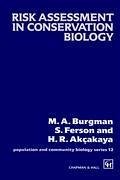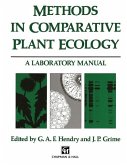This book is a cohesive guide to the available methods that can be used in population viability analysis. It is therefore extremely valuable to both the practitioner of conservation biology and the theoretical population biologist.
Hinweis: Dieser Artikel kann nur an eine deutsche Lieferadresse ausgeliefert werden.
Hinweis: Dieser Artikel kann nur an eine deutsche Lieferadresse ausgeliefert werden.
`...a book written by biologists for biologists...the accounts of the procedures are consistently well balanced and clear, with relevant biology.'
Biodiversity and Conservation
`[This] book will be found invaluable not only by conservation biologists, but by a much wider audience interested in the modeling of real populations. . . . I found the chapters on unstructured and age-structured models particularly enlightening, as they follow a clear path from theory to techniques to case studies. . . . This book is accessible to an unusually broad audience. Required is only `some familiarity with statistics, linear algebra and programming, or at least a lack of fear of these subjects' (right on!). Yet the biologically well-informed discussion of model selection and estimation, and of the limits of model interpretation, should make this book at least as useful to theoreticians in search of applicability as to empirical workers wishing to learn modeling. Plain language and clear examples prevail, yet the tone is never patronizing nor the message oversimplified.'
Trends in Ecology and Evolution
`...Well written and well organized. It provides a basic framework for those interested in population modeling, starting from simple models and gradually increasing their complexity; and shows how these models can be used to assess the risk of extinction of animal or plant populations... [It is] an excellent introduction to the use of mathematical models in conservation biology and risk assessment.'
Natural Resource Modeling
`...the author's style is clear and engaging....this imporatant book will appeal to a far wider audience than its title suggest, and could be profitably read bya wide range of ecologists and conservation biologists.'
The Quarterly Review of Biology
Biodiversity and Conservation
`[This] book will be found invaluable not only by conservation biologists, but by a much wider audience interested in the modeling of real populations. . . . I found the chapters on unstructured and age-structured models particularly enlightening, as they follow a clear path from theory to techniques to case studies. . . . This book is accessible to an unusually broad audience. Required is only `some familiarity with statistics, linear algebra and programming, or at least a lack of fear of these subjects' (right on!). Yet the biologically well-informed discussion of model selection and estimation, and of the limits of model interpretation, should make this book at least as useful to theoreticians in search of applicability as to empirical workers wishing to learn modeling. Plain language and clear examples prevail, yet the tone is never patronizing nor the message oversimplified.'
Trends in Ecology and Evolution
`...Well written and well organized. It provides a basic framework for those interested in population modeling, starting from simple models and gradually increasing their complexity; and shows how these models can be used to assess the risk of extinction of animal or plant populations... [It is] an excellent introduction to the use of mathematical models in conservation biology and risk assessment.'
Natural Resource Modeling
`...the author's style is clear and engaging....this imporatant book will appeal to a far wider audience than its title suggest, and could be profitably read bya wide range of ecologists and conservation biologists.'
The Quarterly Review of Biology
`...a book written by biologists for biologists...the accounts of the procedures are consistently well balanced and clear, with relevant biology.'
Biodiversity and Conservation
`[This] book will be found invaluable not only by conservation biologists, but by a much wider audience interested in the modeling of real populations. . . . I found the chapters on unstructured and age-structured models particularly enlightening, as they follow a clear path from theory to techniques to case studies. . . . This book is accessible to an unusually broad audience. Required is only `some familiarity with statistics, linear algebra and programming, or at least a lack of fear of these subjects' (right on!). Yet the biologically well-informed discussion of model selection and estimation, and of the limits of model interpretation, should make this book at least as useful to theoreticians in search of applicability as to empirical workers wishing to learn modeling. Plain language and clear examples prevail, yet the tone is never patronizing nor the message oversimplified.'
Trends in Ecology and Evolution
`...Well written and well organized. It provides a basic framework for those interested in population modeling, starting from simple models and gradually increasing their complexity; and shows how these models can be used to assess the risk of extinction of animal or plant populations... [It is] an excellent introduction to the use of mathematical models in conservation biology and risk assessment.'
Natural Resource Modeling
`...the author's style is clear and engaging....this imporatant book will appeal to a far wider audience than its title suggest, and could be profitably read bya wide range of ecologists and conservation biologists.'
The Quarterly Review of Biology
Biodiversity and Conservation
`[This] book will be found invaluable not only by conservation biologists, but by a much wider audience interested in the modeling of real populations. . . . I found the chapters on unstructured and age-structured models particularly enlightening, as they follow a clear path from theory to techniques to case studies. . . . This book is accessible to an unusually broad audience. Required is only `some familiarity with statistics, linear algebra and programming, or at least a lack of fear of these subjects' (right on!). Yet the biologically well-informed discussion of model selection and estimation, and of the limits of model interpretation, should make this book at least as useful to theoreticians in search of applicability as to empirical workers wishing to learn modeling. Plain language and clear examples prevail, yet the tone is never patronizing nor the message oversimplified.'
Trends in Ecology and Evolution
`...Well written and well organized. It provides a basic framework for those interested in population modeling, starting from simple models and gradually increasing their complexity; and shows how these models can be used to assess the risk of extinction of animal or plant populations... [It is] an excellent introduction to the use of mathematical models in conservation biology and risk assessment.'
Natural Resource Modeling
`...the author's style is clear and engaging....this imporatant book will appeal to a far wider audience than its title suggest, and could be profitably read bya wide range of ecologists and conservation biologists.'
The Quarterly Review of Biology








